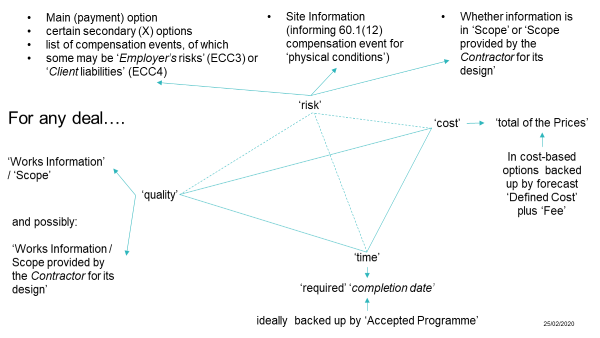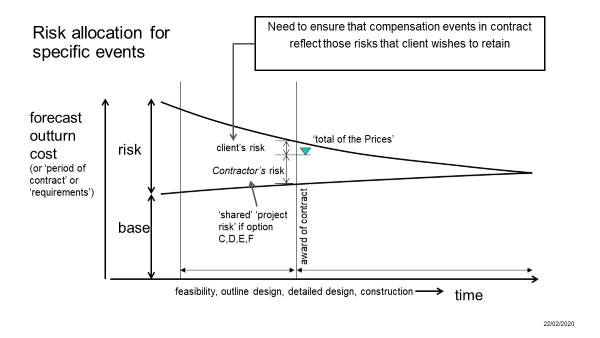
1. The project management tetrahedron
1.1 - Introduction
Anyone who has done any training in project management will recognise the classic project management triangle:
- quality
- cost
- time.
But when it comes to ‘doing a deal’ or writing a contract, this misses one major dimension – risk. The triangle then becomes the tetrahedron shown in Figure 1.
.png)
Figure 1 - The project management tetrahedron
The tetrahedron is explained in terms of the NEC Engineering and Construction Contract (ECC) in the following sections.
1.2 - Quality, time and cost
The ‘quality’ is what is required and any constraints on how that is provided. In NEC4 that is set out in the Client’s Scope (Works Information in NEC3) and may, if requested by the Client, be extended by a document supplied by the bidder, the ‘Scope provided by the Contractor for its design’.
The tendered ‘cost’ in ECC is called the ‘Prices’, which is colloquially a lump sum in ECC option A, a target in ECC option C or D and a budget in ECC option E. In the target and reimbursable options the Prices will be supported by a forecast of ‘Defined Cost’.
The ‘time’ requirement is to achieve ‘Completion’ by the completion date. ECC has options to ask for a programme with the tender or shortly after award.
1.3 - Risk allocation
The risk allocation is achieved in the ECC in several subtle but very clear ways.
1.3.1 - Main option
The Client allocates the ‘quantity risk’ and the ‘efficiency risk’ by its choice of main option.
If it wants to retain the risk of quantities, the Client will choose option B (priced contract with bill of quantities) or option D (target contract with bill of quantities).
If it wants the collaborative benefits of a target contract (tempered by the problems and costs of auditing real costs) it will choose option C (target contact with activity schedule) or option D.
The sharing of the ‘efficiency risk’ ranges from the priced contacts, through the target contracts to option E (cost reimbursable contract). With option A (and B) the efficiency risk is with the Contractor. With option E, that efficiency risk is with the Client – they pay what it costs (subject only to ‘Disallowed Cost’). The target contracts (option C and D) are in between and the sharing of the efficiency risk is set out by the share ranges and share percentages (colloquially the ‘share profile’) that set out how any ‘pain’ or gain’ compared with the target will be shared.
1.3.2 - Secondary Options
The Client also decides risk allocation with its choice of secondary options. The best examples are X1, price adjustment for inflation and X2, changes in the law. If those options are not included, then the Contractor takes the relevant risk.
1.3.3 - Physical Conditions
The contract has a ‘compensation event’ for physical conditions (60.1(12)) that it would have been unreasonable for the tenderer to allow for. What would have been reasonable will be influenced by the factual information that the Client includes in the ‘Site Information’ (60.2). Inclusion of quality factual data in the Site Information helps the tenderer price the physical conditions risk and make it easier to judge if a compensation event has occurred.
1.3.4 - Scope and the Scope provided by the Contractor
The Client has a choice to ask for ‘Scope provided by the Contractor for its design’ as part of the tender submission, or in the case of ‘early contractor involvement’ as part of the development of the final contract. Thanks to clause 60.1(1), the Client’s Scope takes precedence over the Scope provided by the Contractor. So the Contractor takes the risk that the ‘Scope provided by the Contractor’ does not meet the requirements of the Client’s Scope.
1.3.5 - Compensation events
When it comes to specific events, the NEC’s concept of ‘compensation events’ is critical to risk allocation. If an event is a compensation event, the Contractor is compensated for the effect of the event on the time and cost or competing the works (unless the event was due to a ‘fault’ of the Contractor). If an event is not a compensation event the Contractor is deemed to have priced for it.
The ECC has its standard list of compensation events (mainly in clause 60.1). These can be deleted or added to in the additional conditions of contract (option Z). NEC4 also includes 60.1(20) ‘additional compensation events stated in Contract Data part one so the Client can hold back specific risks with a simple entry in the Contract Data.’
1.3.6 - Client liability
One of the compensation events (60.1(14)) is a ‘Client liability’ (this is called an ‘Employer’s risk’ in NEC3). The Client liabilities are listed in clause 80.1 and can be added to in the Contract Data. If a Client liability event occurs, it is a compensation event and so the Contractor is compensated for the time and cost impact on the works. The difference is that for a Client liability the Client also picks up ‘any cost which the Contractor has paid or will pay to Others as a result of an event’ (82.2) and the Contractor does not have to insure against the event (83.3). (‘Others’ are third parties).
Hence a Client has to decide first if an event should be a compensation event and, if so, whether it wants to go further and make it a Client liability. Additional Client liabilities are rarely used. One example of their use is in the nuclear sector, where clients sometimes make a ‘nuclear event’ a Client liability.
2. Compensation Events - an illustration
Compensation events are fundamental to risk allocation.
Figure 2 illustrates the ‘risk funnel’ of a project. Over time and as design progresses the team has a better idea of the ‘base costs’ of the work and gradually reduces the ‘risk allowance’ in the project. The Client chooses the appropriate time to go to tender and ultimately awards a contract. At that stage there are typically still numerous risks. It is for the Client to decide which risks it should take. As described above, it can take further risks by adding to the standard compensation events in the contract. An informed Client will have developed a project risk register to, amongst other things, highlight where risks should be placed. That project risk register itself does NOT go in the contract, but it will inform what should be compensation events.
.png)
Figure 2 - Risk allocation for specific events
Figure 2 shows that risk allowances for anything that is not a compensation event must be included by the bidder within the Prices. All ‘Contractor’s risks’ are included in the Prices. Whilst the contract calls these ‘Contractor’s risks’, it is important to realise that in the cost based contracts (options C, D, E and F) the cost of mitigating against and dealing with those ‘Contractor’s risks’ is effectively paid by the Client. Hence in the project team they are better called ‘shared’ or ‘project risks’.
In summary compensation events are a critical part of risk allocation in the ECC contract when it comes to specific events.




